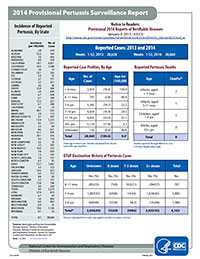Public Health Professionals
There are resources located throughout this website that are especially relevant to public health professionals. Listed below are key resources.
Case Definition
State health departments report pertussis cases to CDC through the National Notifiable Diseases Surveillance System (NNDSS) using a standardized case definition accepted by the Council of State and Territorial Epidemiologists. Read more about the pertussis case definition.
Surveillance Reports

Pertussis reporting data are summarized each year in provisional and final reports. See recent surveillance reports.
Reporting Trends
Pertussis is nationally-notifiable and clinicians should notify the appropriate health department of all patients with suspected pertussis. Similarly, diagnostic laboratories should notify health departments of all positive pertussis laboratory results. State health departments then report confirmed and probable pertussis cases to CDC through NNDSS. Although many pertussis cases are not diagnosed and therefore not reported, the surveillance system is useful for monitoring epidemiologic trends. View historic and recent reporting trends.
Postexposure Antimicrobial Prophylaxis
The primary objective of postexposure antimicrobial prophylaxis (PEP) should be to prevent death and serious complications from pertussis in individuals at increased risk of severe disease. Learn more about PEP for pertussis.
Letter of Guidance for Use during Outbreaks
This draft letter can be adapted for use during pertussis outbreaks in schools or other closed or contained settings. View the letter of guidance.
Specimen Collection
Determining who has pertussis can be difficult. Whenever possible, clinicians should obtain a nasopharyngeal (NP) swab or aspirate from all suspected cases. A properly obtained NP swab or aspirate is essential for optimal results. Learn more about and watch videos demonstrating how to perform NP specimen collection.
Diagnosis Confirmation
Clinicians commonly use several types of laboratory tests to diagnose Bordetella pertussis. Laboratory scientists consider culture to be the gold standard because it is the only 100% specific method for identification; however, laboratory scientists can perform other tests, including polymerase chain reaction (PCR) and serology. Read more about the diagnosis and confirmation of pertussis.
Surveillance Manual
The Manual for the Surveillance of Vaccine-Preventable Diseases provides current guidelines for those directly involved in surveillance of vaccine-preventable diseases, especially personnel at state and local health departments. View the pertussis chapter.
- Page last reviewed: August 7, 2017
- Page last updated: August 7, 2017
- Content source:


 ShareCompartir
ShareCompartir